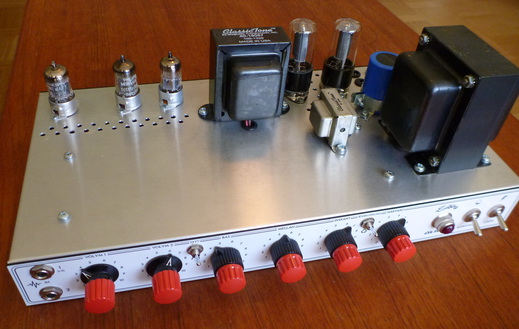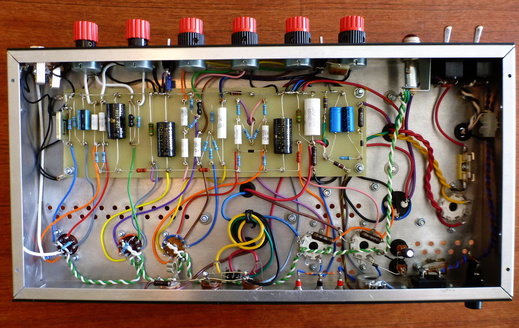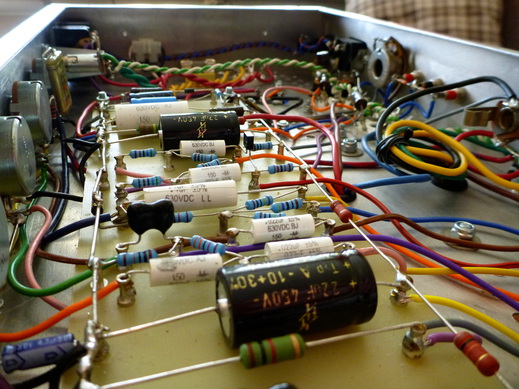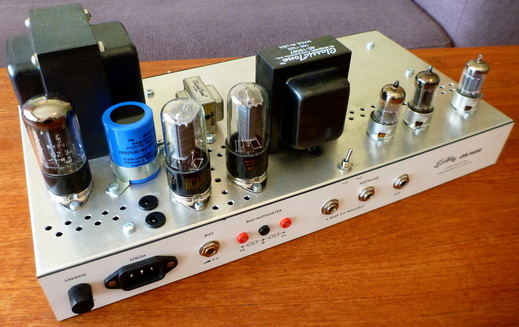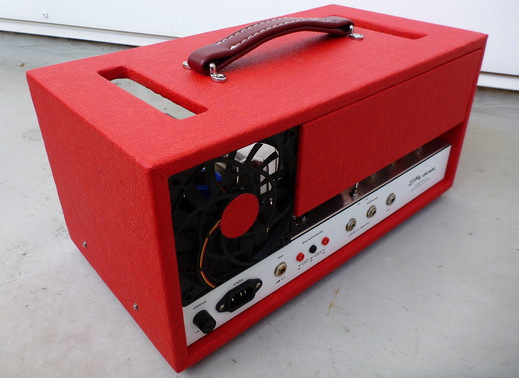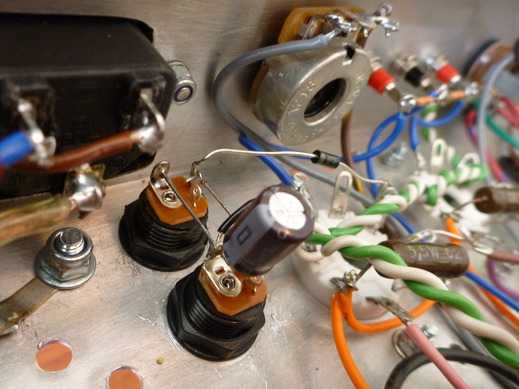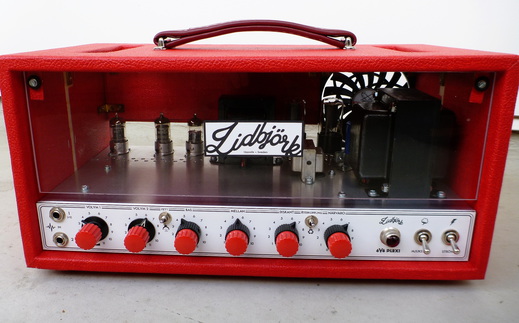Henrik's tube amp builds
6V6 Plexi
Ten years since the Tremolux-build, I decided it was finally time for a new amp project, and this time it was gonna be a Marshall style amp. I wanted to get fairly close to how Clapton sounded with Cream in '68, or Leslie West in '71, or at the very least a decent classic rock tone.
The most obvious choice for a schematic would be any of the numerous EL84 18 Watt amps, but none
of the sound demos I found convinced me; I thought most of them sounded too much “classic rock” in a generic way, or a little fizzy. On the other hand, I really
liked the fat plexi sound in Mark Huss' Plexi6V6
sound clips, as well as this demo of a KO Plexi Amp. So I decided to build
Mark Huss' Plexi 6V6, which is nearly identical to the
October at ax84.com.
The preamp is pretty much straight from a model 1959 Marshall Plexi, while the power amp has been slightly modified to accomodate two 6V6s instead of the usual larger EL34 tubes.
This time I went with Classictone transformers, which are vintage-style, made in the USA, cheaper than Hammonds and have gotten rave reviews on the web. The OT puts out around 22 watts, so this is my most powerful amp to date.
I was also lucky to have access to a component supply at the Update Computer Club at Uppsala University, from which I got those nice red knobs, among many other parts. The rest came mostly from Hoffman Amps and Tube Town. All in all, this amp has components from Canada (chassis), USA (trannies, jacks, tubes, etc.), Germany (caps, tubes), the UK (sockets, tubes), France (knobs), Japan (mini switches), Sweden (faceplate), and probably several other places.
By far, this is my biggest, most complex and ambitious amp build to date. I used the same basic Hammond chassis and turret board parts as my previous projects, recalling as much as possible of the skills I aquired ten years ago when I made the Tremolux, while trying to improve several things on top of that. It amounted to tons of trial-and-error, parts swapping and resoldering, but the effort paid off – this is easily the most clean circuit I've made.
A big thanks should also go to the good folks over at the AX84 and PPWatt forums. Without them, I couldn't have built any of my tube amps.
Despite all that, I'm not entirely satisfied with the layout; in an effort to space things out and keep the heater wiring near the back, I placed the tube sockets unnecessarily far from the circuit board, resulting in long wires between board and tubes. Also, the filter cap can ended up kinda squeezed between the power and rectifier tubes, exposing it to a fair amount of heat. Apart from those quibbles, I'm happy with it, and the amp is not unusually noisy.
It does have some extra bells and whistles. I gave it three speaker jacks and one impedance switch, amounting to a possibility of five different speaker/impedance configurations. The standby switch is a “soft start” switch with a resistor across it, as The Valve Wizard demonstrates on his site. It has multimeter jacks on the back for biasing without pulling the chassis out of the cabinet, though I haven't utilized that possibility yet.
Perhaps the most excessive feature is the cooling fan in the back. Opinions on the benefits of such a thing varies widely on the web, but I had a 12 V computer fan laying around, and I found that you can rectify the 6.3 V heater current and supply the fan with that (provided that the PT has enough current to spare). It will run slower than what it was designed for, but it works fine. The rectified 6.3 VAC power turned out to be 8.9 VDC – ideal for standard 9 V DC jacks, so I installed two of those (see chassis pic above) and plugged the fan into one of them.
The fan blows air out of the chassis and to enable good air flow I cut two vent holes in the cabinet roof (like on the Tremolux) and one hole in the underside, covering the latter with a computer ventilation grill. On top of that I drilled a bunch of small holes in the chassis as can be seen above.
So does it make a difference? I would say yes! Sticking my hand into the cabinet through the top ventilation holes, I can feel the air flowing, and overall it's cooler in there compared to my Tremolux and P1 amps.
For the outside stuff, I pretty much mirrored my previous builds; the cab is made of plywood and covered in red tolex from Tube Town. The faceplate was drawn in Inkscape and engraved by Skövde Gravyr. If you're not based in Sweden like I am, I would still definitely recommend BNP Lasers for faceplates. Germany-based Tube Town also make plates, for those of you in Europe.
I tried to be a little creative with the design, drawing a small symbol for every knob and switch, kinda like Orange did in the '70s. So there's a sumo wrestler at the fat switch and a cotton bud for the soft switch, and – naturally – “The Object” by the Presence control. Actually, I'm thinking of redesigning the plate with the symbols above the knobs instead, so they're more visible.
So, finally, how does it sound? Well, great! Honestly, it doesn't differ as much from the P1 and Tremolux as I hoped. But it sure has a Marshall sound to it, and I can get a pretty fair snarly Leslie West sound of it, especially when cranking volume two, which is the non-bright or “normal” channel. The tone controls aren't super-effective (as expected) but useful. It's also great to be able to mix volume 1 and 2 to dial in the right amount of fatness and brightness. Compared to the Tremolux, this amp has more range on the volume and doesn't distort quite as quickly, which I appreciate.
I was disappointed at first with the presence control, which did almost nothing, so I modified it a bit and increased the negative feedback (the “depth” of the presence) by lowering the nfb resistor from 100 k to 33 k. This made the presence knob and the negative feedback switch more effective. I prefer the sound without nfb but enable it sometimes to tame the power.
Actually, so far I've been more impressed with the Strat tones I got with this amp, over the slightly more popular humbucker/Les Paul setup. Fantastic Hendrix style overdriven sounds with endless possibilites for psychedelic fuzz and wah stuff. Very cool jangly clean sounds in the vein of Wind Cries Mary, White Summer/Black Mountain Side and No No No.
When I get the time, I'm hoping to record some new demonstration videos of all my amps. For the moment, the best way to hear my P1 and Tremolux is in my video game covers at Mutherpluckin' B, which are recorded almost exclusively with those amps.
henrik . lidbjork ✇ gmail . com
Parts List
Schematic (by Mark Huss)
Presence/NFB circuit
Layout sketch
Cooling fan circuit
References
AX84 Community
PPWatt.com
18Watt.com
The Valve Wizard
Paul Ruby's Tech Info
Casey4s' Tolexing Guide
Hoffman Amps (parts)
Tube Town (German store)
Triode Electronics (store)
Apex Jr. (surplus parts)
BNP Laser Engraving
Classictone transformers
Glasklart (Swedish glazier)
Update Computer Club

